 United Kingdom (1914) – Seaplane Carrier
United Kingdom (1914) – Seaplane CarrierWW1/WW2 RN Aircraft Carriers:
ww1 seaplane carriers | Ark royal (1914) | Campania | Furious | Argus | Hermes | Eagle | Courageous class | Ark Royal (1936) | Illustrious class | Implacable class | Colossus class | Majestic class | Centaur class | Unicorn | Audacity | Archer | Avenger class | Attacker class | HMS Activity | HMS Pretoria Castle | Ameer class | Merchant Aircraft Carriers | Vindex classHistory’s first purpose-built seaplane carrier
HMS Ark Royal is a famous name, as it went back to Elizabethan times (1587) but was used only with this ship and became even more famous in the interwar as the most modern, purpose-built British aircraft carrier. But back in WW1, she was the sole purpose-built seaplane carrier. The hull was purchased by the Royal Navy shortly after she had been laid down, in frames when the war broke out. The design was therefore completely revised to accommodate seaplanes. She served first at Gallipoli and had an active career well into 1920, was converted as a training ship in the interwar and served in WW2 as well (as HMS Pegasus) to test MAC-ship catapults.
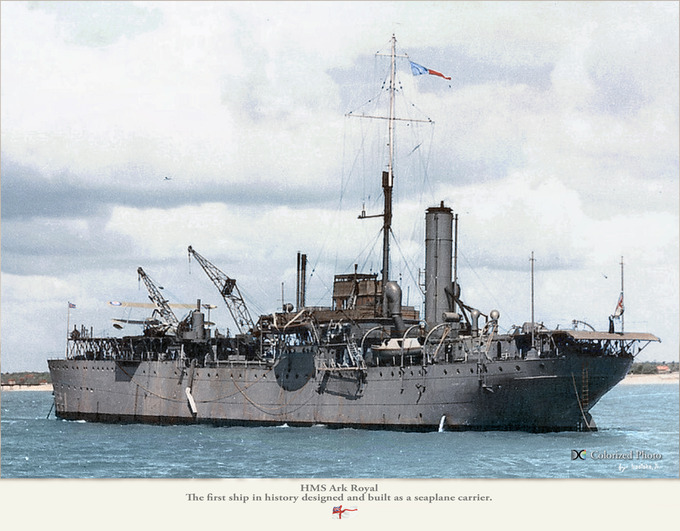
Ark Royal Colorized by IrootokoJr src
Before her, the Royal Navy had already performed trials in 1913 with HMS Hermes, modified to operate seaplanes and evaluate such use within the fleet. The success of this campaign led the Admiralty to allocate £81,000 in the new wartime Naval Programme to purchase and transform a merchant ship. The tramp steamer considered was then in construction at Blyth Yard (Northumberland) in very early stage, which allowed to revise the design entirely. She had been first laid down in November 1913 as a freighter, purchased in May 1914. After conversion, she was launched on 5 September 1914 and commissioned on 10 December 1914.
Design of the Ark Royal
HMS Ark Royal was 366 feet long by 50 feet 10 inches for 18 feet 9 inches (5.7 m) in draught, 7,080 long tons (7,190 t) displacement (7,450 long tons (7,570 t) fully loaded. She was propelled by a single vertical triple-expansion steam engine (one propeller), fed by three cylindrical boilers. Rated power was 3,000 indicated horsepower (2,200 kW) for a designed speed of 11 knots (20 km/h; 13 mph). In trials, she was only capable to reach 10.64 knots (19.71 km/h; 12.24 mph) at 2,675 shaft horsepower. Her trials took place in December 1914. She also carried 500 tonnes (490 long tons) of fuel oil for a 3,030 nautical miles (5,610 km; 3,490 mi) range.
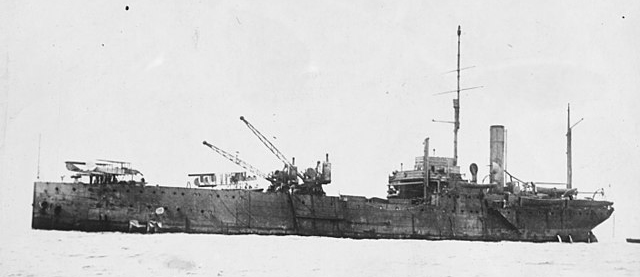
Modifications included a revised configuration to serve as a seaplane tender. The entire superstructure, funnel, propulsion section was moved aft. A clear working deck was installed on her forward half. It was not used for flying-off the planes but rather managing them from the hangar, starting and running up their engines, recovering and stored damaged aircraft. The hull hangar was a 150 feet (45.7 m) long, 45 feet (13.7 m) wide, 15 feet (4.6 m) high hold. It was large enough to accommodate extensive workshops. To operate the planes, two steam cranes were installed on the sides of the forecastle. These 3-long-ton (3.0 t) cranes lifted the aircraft through the hangar’s sliding hatch onto the flight deck, but also in and out of the water. To support plane operations she also carried 4,000 imperial gallons (18,000 l; 4,800 US gal) of petrol. This was standard commercial 2-imperial-gallon (9.1 l; 2.4 US gal).
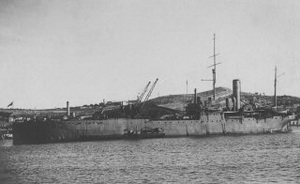
HMS Ark Royal was armed with four QF 12-pounder 12 cwt guns and two machine guns. Her crew consisted in 180 officers and men plus 60 aviation personnel. Rather unique, she was fitted with a steadying sail on the mizzen to stay on course in the wind. That built-in solution was never reused again. Perhaps however, we can think of the solution used on (USS Essex?) in 1944, when badly damaged by Kamikazes, she was able to sail on wind power with an improvised sail…
Normal provision for the onboard squadron was five seaplanes, but also 2-4 wheeled aircraft. They took off from the platform, and landed on the coast after the operation, while the seaplanes operated at all times with the carrier. She carried normally a Short 184 with Folding wings, two Wright Pushers, but also three Sopwith Type 807. She also operated in one-off mode 2-4 Sopwith Tabloid.
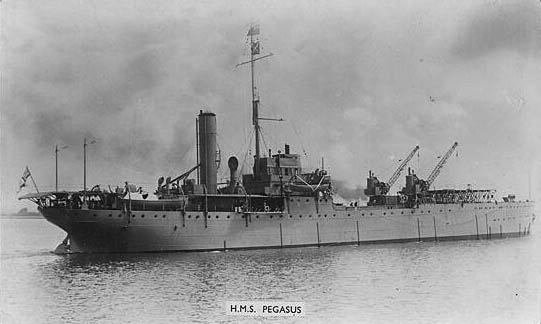
HMS Ark Royal in the interwar years
Career of the Ark Royal
The first mission of the Ark Royal was the Gallipoli Campaign in early 1915. She provided aerial reconnaissance and observation for the artillery. Her second affectation was the Macedonian Front in 1916, supporting British troops. She returned to the Dardanelles as a depot ship for seaplanes operating of the area and in January 1918 her seaplanes tried to sink the Yavuz (Former German battlecruiser SMS Goeben) during the battle of Imbros. She then conducted ASW patrols over the southern Aegean Sea.
After the war, HMS Ark Royal was used as an aircraft transport and depot ship. She operated in support of White Russian and British troops against the Bolsheviks in the Caspian Sea and the Black Sea area. The next year she was sent in Africa, conveying and supplying Royal Air Force aircraft in British Somaliland to deal with an insurrection. When she returned home, she was placed in reserve but recommissioned to carry squadron to the Dardanelles (Chanak Crisis in 1922). By 1923 she was placed in reserve again.
Recommissioned in 1930 she was used for training seaplane pilots. She also participated in aircraft catapult tests and further launch training. Renamed at last HMS Pegasus in 1934, she served until the beginning of WW2. She started a new wartime career as an aircraft transport, and training ship. But soon she was modified to test a new model of prototype fighter catapult ship. in fact, she was the test ship for the whole serie of CAM-ship conversions. The principle was to launch a land-base, carriage-less plane from a catapult when a German long-range reconnaissance plane was spotted.
Indeed this plane, the Fw-200 “Kondor” was used by the German admiralty submarine branch based at Lorient HQ to track convoys and report their position back to the HQ that coordinated U-boats packs. Until then, British sailors could only raise their fist in defiance as no escort aircraft carrier was available, they will arrive gradually years later. So the use of a Hurricane that was not recovered after its launch was judged worth the cost.
Pegasus served as the first British MAC-ship until mid-1941. She was back to training duties until early 1944, converted to a barracks ship. Sold in 1946 and was taken over for civilian reconversion in 1947. However, the new owner bankrupted and SS Anita I (her new name) was seized by the owner’s creditors in 1949 and sold for scrap.
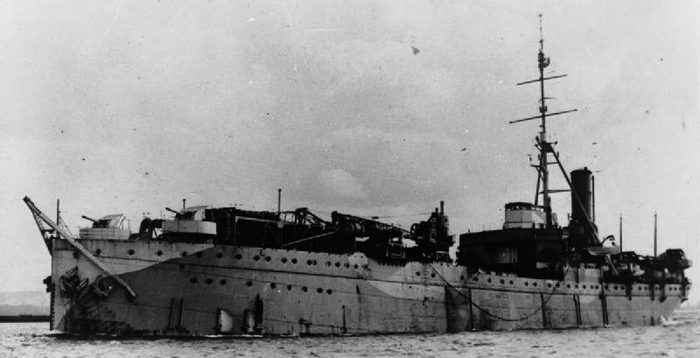
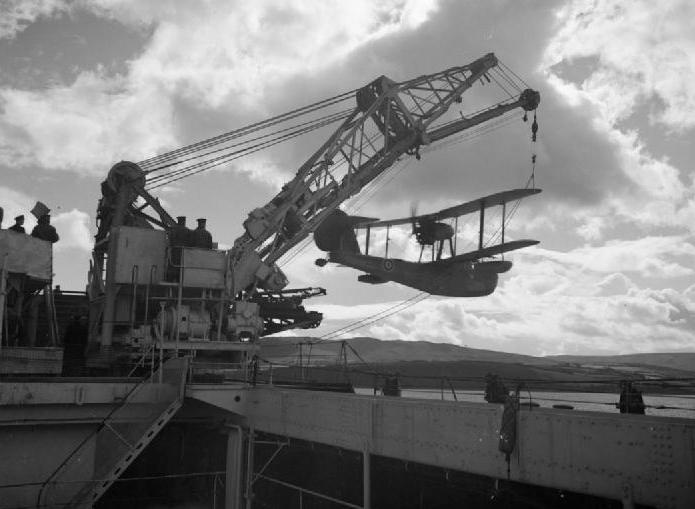
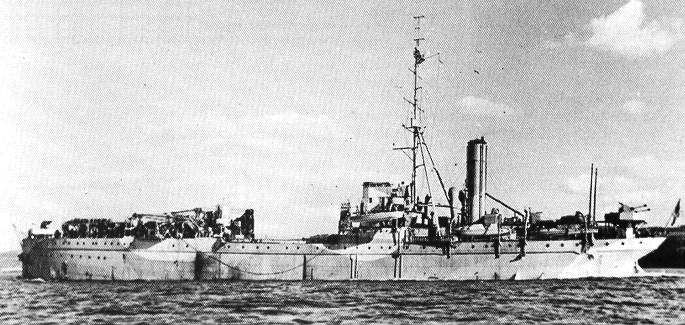
HMS Pegasus in operations during WW2
Ark Royal (1914) |
|
| Dimensions | 111.6 x 15.5 x 5.7 m (366 ft x 50 ft 10 in x 18 ft 9 in) |
| Displacement | 7,080 long tons standard – 7,450 long tons FL |
| Crew | 180 |
| Propulsion | 1 shaft VTE 3,000 shp (2,200 kW) |
| Speed | 11 knots (20 kph 13 mph) |
| Armament | 3 x12 Pdr QF, 2 x13 mm AA MGs, 8 planes (see notes). |
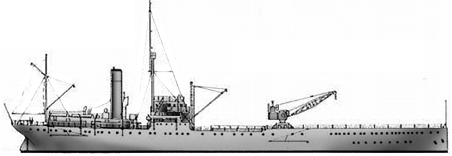
Author’s profile of the Ark Royal in 1914
Links – Read More
HMS pegasus (ww2) on naval-history.net
HMS_Ark_Royal_(1914) (wiki)
On hazegray.org
Conway’s all the world’s fighting ships 1906-1921

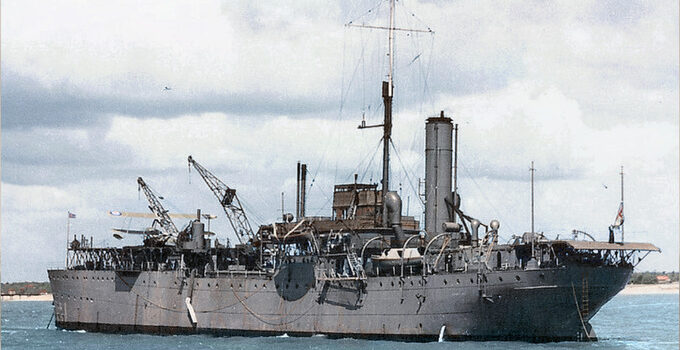
 Latest Facebook Entry -
Latest Facebook Entry -  X(Tweeter) Naval Encyclopedia's deck archive
X(Tweeter) Naval Encyclopedia's deck archive Instagram (@navalencyc)
Instagram (@navalencyc)





 French Navy
French Navy Royal Navy
Royal Navy Russian Navy
Russian Navy Armada Espanola
Armada Espanola Austrian Navy
Austrian Navy K.u.K. Kriegsmarine
K.u.K. Kriegsmarine Dansk Marine
Dansk Marine Nautiko Hellenon
Nautiko Hellenon Koninklije Marine 1870
Koninklije Marine 1870 Marinha do Brasil
Marinha do Brasil Osmanlı Donanması
Osmanlı Donanması Marina Do Peru
Marina Do Peru Marinha do Portugal
Marinha do Portugal Regia Marina 1870
Regia Marina 1870 Nihhon Kaigun 1870
Nihhon Kaigun 1870 Preußische Marine 1870
Preußische Marine 1870 Russkiy Flot 1870
Russkiy Flot 1870 Svenska marinen
Svenska marinen Søværnet
Søværnet Union Navy
Union Navy Confederate Navy
Confederate Navy Armada de Argentina
Armada de Argentina Imperial Chinese Navy
Imperial Chinese Navy Marinha do Portugal
Marinha do Portugal Mexico
Mexico Kaiserliche Marine
Kaiserliche Marine 1898 US Navy
1898 US Navy Sovietskiy Flot
Sovietskiy Flot Royal Canadian Navy
Royal Canadian Navy Royal Australian Navy
Royal Australian Navy RNZN Fleet
RNZN Fleet Chinese Navy 1937
Chinese Navy 1937 Kriegsmarine
Kriegsmarine Chilean Navy
Chilean Navy Danish Navy
Danish Navy Finnish Navy
Finnish Navy Hellenic Navy
Hellenic Navy Polish Navy
Polish Navy Romanian Navy
Romanian Navy Turkish Navy
Turkish Navy Royal Yugoslav Navy
Royal Yugoslav Navy Royal Thai Navy
Royal Thai Navy Minor Navies
Minor Navies Albania
Albania Austria
Austria Belgium
Belgium Columbia
Columbia Costa Rica
Costa Rica Cuba
Cuba Czechoslovakia
Czechoslovakia Dominican Republic
Dominican Republic Haiti
Haiti Hungary
Hungary Honduras
Honduras Estonia
Estonia Iceland
Iceland Eire
Eire Equador
Equador Iran
Iran Iraq
Iraq Latvia
Latvia Liberia
Liberia Lithuania
Lithuania Mandchukuo
Mandchukuo Morocco
Morocco Nicaragua
Nicaragua Persia
Persia San Salvador
San Salvador Sarawak
Sarawak Uruguay
Uruguay Venezuela
Venezuela Zanzibar
Zanzibar Warsaw Pact Navies
Warsaw Pact Navies Bulgaria
Bulgaria Hungary
Hungary

 Bundesmarine
Bundesmarine Dutch Navy
Dutch Navy Hellenic Navy
Hellenic Navy Marina Militare
Marina Militare Yugoslav Navy
Yugoslav Navy Chinese Navy
Chinese Navy Indian Navy
Indian Navy Indonesian Navy
Indonesian Navy JMSDF
JMSDF North Korean Navy
North Korean Navy Pakistani Navy
Pakistani Navy Philippines Navy
Philippines Navy ROKN
ROKN Rep. of Singapore Navy
Rep. of Singapore Navy Taiwanese Navy
Taiwanese Navy IDF Navy
IDF Navy Saudi Navy
Saudi Navy Royal New Zealand Navy
Royal New Zealand Navy Egyptian Navy
Egyptian Navy South African Navy
South African Navy






























 Ukrainian Navy
Ukrainian Navy dbodesign
dbodesign
My grandfather James Stuart served aboard this vessel, as a very young ordinary seaman, he lived in the mining village of Cambois, on opposite banks of the river Blyth, after the war, he returned home, and spent the rest of his working life, in the coal mines. Was wondering how to find out more, about time in the navy
Thanks for your input Brian !
Have no more info about the crew than you do.
Cheers,
I have been restoring some images that were handed down to me. A family member of mine, Will Smith, was part of the RNAS contingent on Ark Royal. I can share those in case anyone recognizes family but there seems to be a lot more information about the air crew than anyone else serving on Ark Royal during the Dardanelles and Salonika campaigns.
Thx Alasdair, if you wish to publish one for others to recognise, feel free to do so here, if possible.
Hi Alasdair Greig, I live in Blyth, Northumberland the birthplace of HMS ARK ROYAL (1914) and am on the process of making a documentary on the design, build, and service of the ARK, and subsequently her service as HMS PEGASUS from 1934 to 1946. I would love to see those photographs of the RNAS personal if you would care to share?
There is a shipbuilders model from 1914 of the ARK in Blyth Library, it has fascinated me since I was a child and is the impetus to produce the documentary
regards,
Vic
My Great great uncle William Smith served on HMS Ark Royal during World War One I believe he was a carpenter working on the sea planes he was awarded the DSO whilst serving on her. I still have his handmade wooden tool box and a couple of set squares
Thanks for the info !